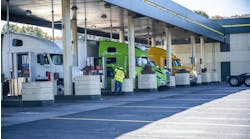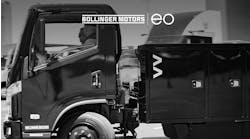For many fleets, the possibility of switching from diesel to natural gas is intriguing, and in some specialized applications like refuse collection, natural gas-powered trucks are already common. For most trucking operations though, especially ones involving Class 8 payloads and long distances, natural gas is still a question mark. It is an alternative fuel that seems to have great potential for improving both operating costs and environmental sustainability, but one that has yet to prove its viability as an everyday fuel for a working fleet. The response has been a large number of pilot programs to test the concept, but little wholesale adoption among over-the-road fleets.
Saddle Creek Transportation is an exception. As the trucking arm of Saddle Creek Logistics, it operates 440 Class 8 tractors providing regional contract carriage throughout the U.S. for major consumer-goods manufacturers and retailers, supporting its parent’s contract warehousing and distribution services.
Rather than wait for others to make a business case for natural gas as an OTR fuel, Saddle Creek has taken the bull by the horns and mounted a full-scale program to develop both tractors and fueling stations that make compressed natural gas (CNG) a practical alternative for a large portion of its operation. Since taking delivery of its first 40 CNG tractors back in 2012, Saddle Creek has accumulated 17 million mi. in OTR Class 8 heavy-haul operations achieving an estimated reduction of 55,000 lbs. in carbon emissions. Today, it runs 150 CNG trucks and will take delivery of another 50, representing the fourth generation of its development work with truck and fuel-system manufacturers, before the end of the year.
Such commitment requires strong motivation and a solid understanding of long-term goals, according to Mike DelBovo, president of Saddle Creek Transportation. When it first began investigating NG in 2011, part of that motivation was a corporate green initiative that also reflected similar initiatives underway at its largest customers. Long-term sustainability, both in terms of fuel availability and cost stability, were also significant factors. And just as importantly, Saddle Creek was motivated by a positive business case.
“Our business is moving stuff for customers,” DelBovo says. “How can you do that at the lowest sustained cost in the most environmentally conscious way? This program isn’t about buying natural gas trucks, it’s about reducing overall cost long term with the most efficient movement of goods. It takes a whole package—better natural gas trucks, higher capacity trailers, more efficient CNG fueling stations.”
Cooperative effort
It also requires some long-term vision and patience to work through development bumps of a new technology. In Saddle Creek’s case, that’s meant developing close cooperation with Freightliner, its truck maker; Agility, the supplier of its CNG on-vehicle tanks; and even Clean Energy, the designer of its CNG fueling stations.
“When you’re engineering things for the first time, it’s exciting, frustrating and rewarding all at the same time,” says DelBovo. “But it would make a good case study in collaboration. You truly have to partner with your vendors and your customers to make it happen.”
The fleet’s first 40 CNG tractors back in 2012 were Freightliner M2 models with 9L Cummins ISL G engines. While they proved CNG could work in Saddle Creek’s operations, their 500-mi. range wasn’t going to be good enough, so working with Freightliner and Agility, Saddle Creek took delivery of 60 second-generation CNG M2s that extended that range to 600 mi.
A third generation followed quickly: Freightliner Cascadia tractors powered by the Cummins Westport ISX12 G NG engine. The tractors carried yet another improved CNG storage tank system and aerodynamics adapted from the Cascadia Evolution. The result was a 700-mi. range, which DelBovo had initially set as ideal for Saddle Creek’s operations.
While the range was right, Saddle Creek never lost sight of the big picture, which was overall efficiency, so attention was turned to vehicle weight. While the third-generation CNG trucks carried a weight penalty compared to diesel versions, the partners have now created a fourth-generation CNG tractor that retains the 700-mi. range but boosts payload to 50,000 lbs.
The ISX G-powered Cascadia carries even more of the Evolution’s aerodynamics and attention was paid to matching the right transmission, rear axles and other components to achieve that payload. Paired with a high-cube trailer properly loaded, the new CNG combination now matches Saddle Creek’s payload for its diesel equipment while preserving the range it requires. The first of these newest CNG Cascadias has already been delivered, and the company has ordered another 25 for delivery before the end of the year. When they are delivered, 200 of Saddle Creek’s 440 tractors will be running on CNG.
Business model
A major contributor to both the weight loss and improved aerodynamics of this fourth-generation tractor is a new Agility “fuel box” that eliminates the need for saddle tanks and tucks all of the CNG storage behind the cab fairings. “Not only is [the tank system] lighter and more aerodynamic, but the whole package can be moved to another truck as a single unit,” says DelBovo. Given the high cost of CNG on-vehicle storage, being able to stretch that cost out over more than the life of one truck will provide a major cost savings, he points out.
Which brings us to the most critical element in Saddle Creek’s CNG strategy, the economic business model. In order to be successful, the transition to natural gas has to make real economic sense over the long term, says DelBovo. While many OTR fleets have traditionally worked with three-year trade cycles, Saddle Creek runs its equipment longer, allowing it to benefit from a 50-month ROI on its CNG investments, an ROI to be achieved without any government incentives.
It’s important to Saddle Creek that calculating ROI is an honest exercise that goes well beyond the lower fuel price of NG and the higher initial cost of the tractors. “There are lots of hidden costs in this beyond the initial cost increases,” says DelBovo. “Maintenance costs are higher and operations are more expensive. You have additional costs for maintaining the fuel stations and for training drivers. And there’s more vehicle downtime.”
On the horizon
The exceptionally cold winter has raised NG prices enough to keep Saddle Creek a bit short of its 50-month ROI goal, but DelBovo believes it’s now well within reach. “We’ve already seen the raw material price drop dramatically in just the last week, and as the OEMs move [CNG tractor assembly] onto their production lines, the cost will drop and deliveries will be faster,” he says. “So our ROI is still a bit longer than 50 months, but we’re encouraged we’ll get there.”
Now that it has the right CNG tractor, Saddle Creek’s next horizon is improving its fueling stations. Currently, the company runs its CNG equipment in two regional operations, one out of its Lakeland, FL, company headquarters and the other at a distribution facility in Atlanta. A third is currently being added in Ft. Worth, TX. In all three, the company owns or has access to dedicated CNG fueling stations that provide both fast-fill and time-fill pumps designed to handle tractor-trailer combinations.
While a fast-fill pump can refuel a CNG tractor in roughly the same time as it takes to refuel a diesel, it reduces overall range because the faster fill rate heats the CNG enough to cause expansion of the gas and lower overall tank capacity. A time-fill pump can maximize CNG tank capacity, but requires hours, not minutes, to refuel a long-haul tractor. “We’re now working with Clean Energy to look at how we can fast-fill trucks for better range and at ways to reduce the cost of the stations themselves,” says DelBovo.
Preparing drivers
At the same time, the fleet is bringing in all of its driver trainers to familiarize them with the newest CNG technology. “You can’t just drop drivers into these new trucks and assume they understand how to operate them,” says DelBovo.
While there are areas in the country where the infrastructure won’t support replacing diesel trucks with CNG-powered ones, the company is already being approached by other customers interested in expanding the use of a sustainable fuel like CNG in their distribution operations.
“Long range, I think we’ll have a two-to-one natural gas to diesel ratio,” says DelBovo. “We’ve learned that sustainability requires a complex approach, but we’re going to continue prudent investment [in CNG] because this is a true solution for us, not an experiment.”
Proof of concept
Saddle Creek Transportation operates a number of regional distribution fleets throughout the country, and it’s carefully developed its CNG tractor fleet to best serve that application with a 700-mi. fuel range. However, the fleet believes its new fourth-generation CNG tractor, a Freightliner Cascadia powered by a Cummins Westport ISX12 G engine and fitted with advanced aerodynamics adapted from the Cascadia Evolution, could be capable in even longer haul applications. And recently, it got the chance to put that belief to the test.
“We needed to get the new truck out to the West Coast for display at a conference,” says John Erwin, director of transportation. “We decided we could drive it out there [from Lakeland, FL] with a revenue load instead of putting it on a flatbed if we planned it right.”
Using 600 mi. as a practical daily goal for the driver, Erwin and Saddle Creek Transportation president Mike DelBovo mapped out a path that covered the 3,000-mi. route in daily legs between available CNG fueling locations. Saddle Creek customer P&G signed on for the westbound move, and Lowe’s Home Improvement provided a load for the eastbound trip back to Florida.
“There are enough fueling locations to make the trip, but we had to do some homework,” says Erwin. Each location had to be contacted to find out its hours of operation and whether it could handle a tractor-trailer combination. Since some weren’t public facilities, even payment had to be worked out ahead of time.
“One thing we didn’t consider is availability of the right oil for the CNG engine,” says DelBovo. “It’s a special oil and not everyone carries it.”
In the end, the truck delivered its load, showed up for the conference, and made it back to Florida with the return load without incident. “Not many people are hauling freight with CNG, so it was a real novelty out on the road,” says Erwin. “Every port of entry was an event.”
A video on the cross country trip is available online at http://youtu.be/iMtg8g62obA.



